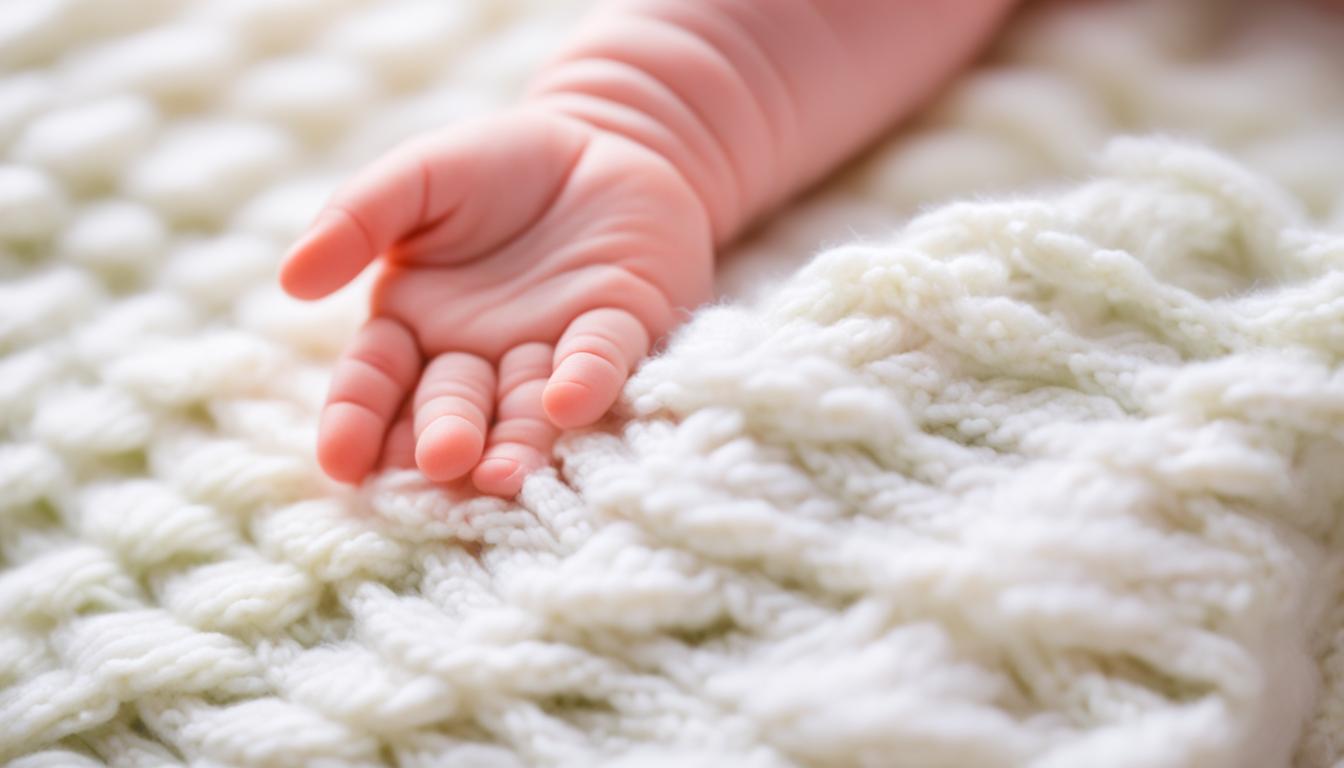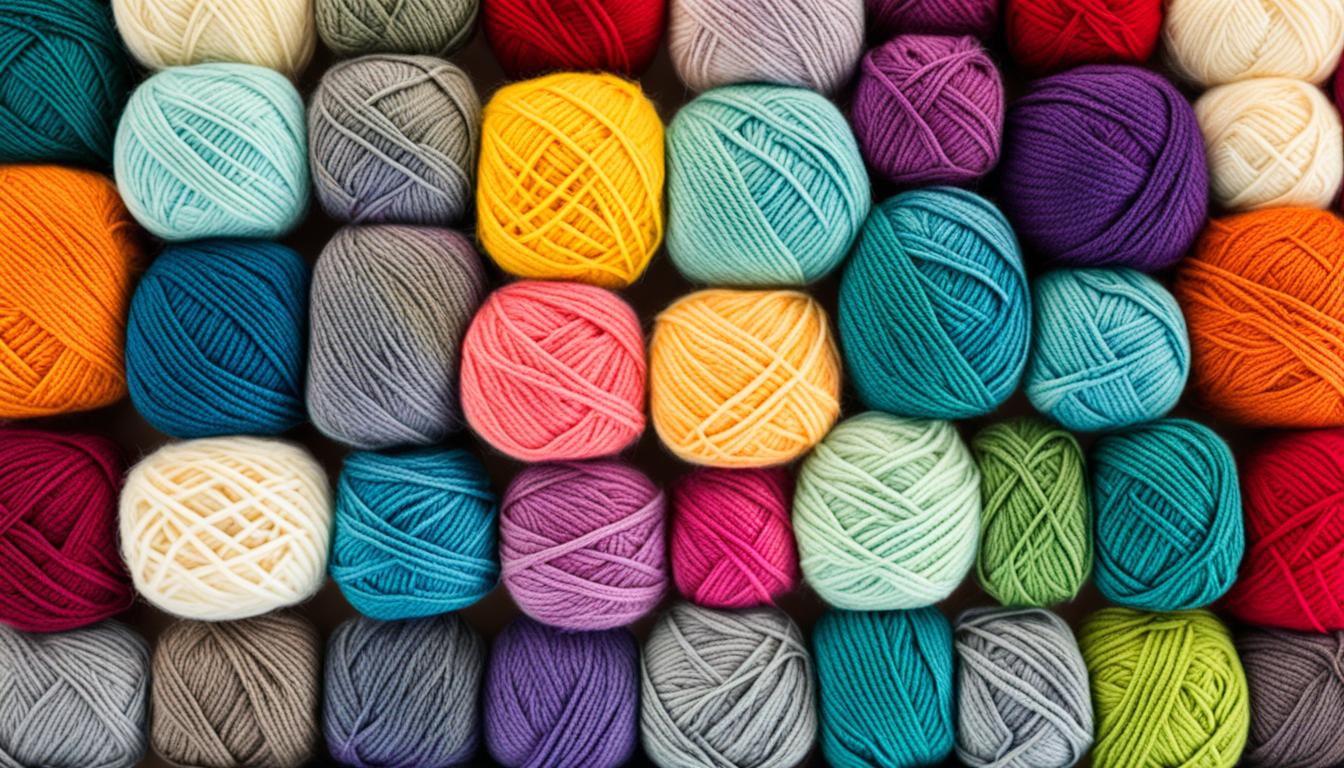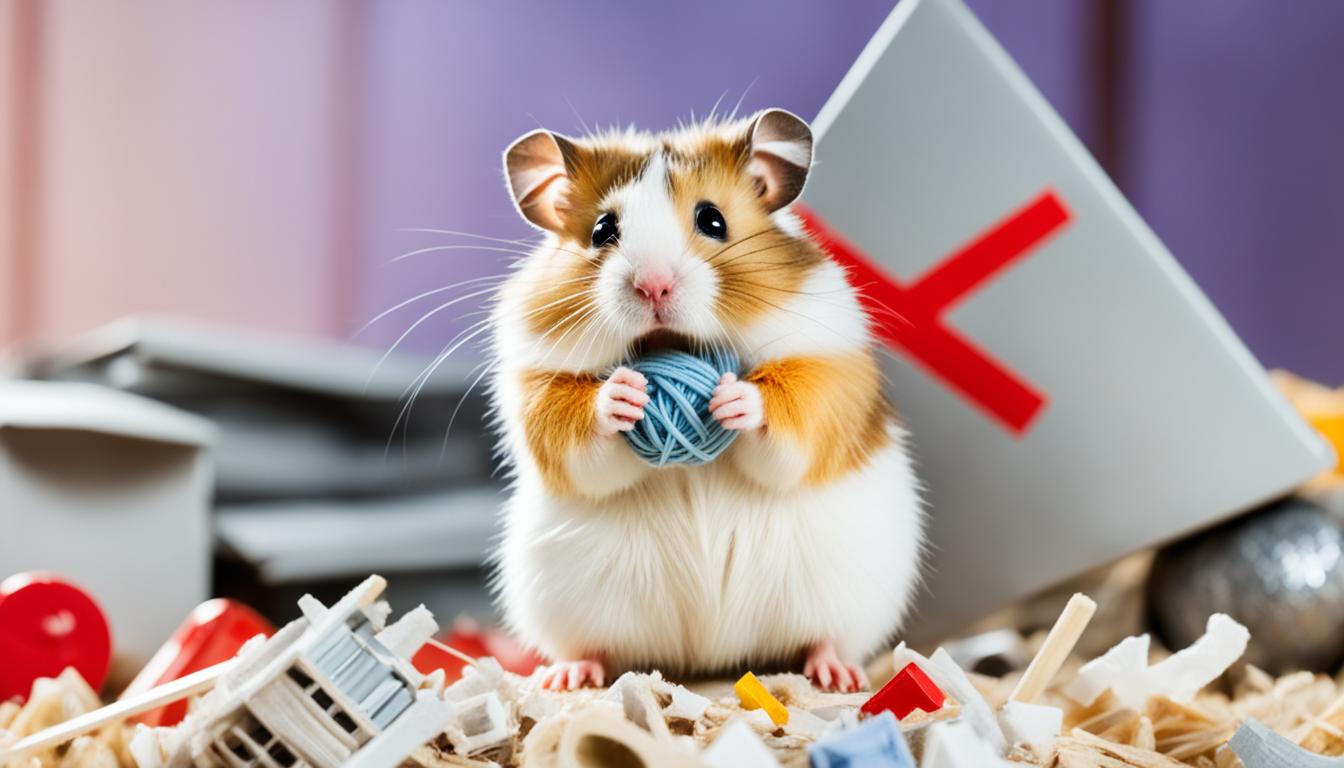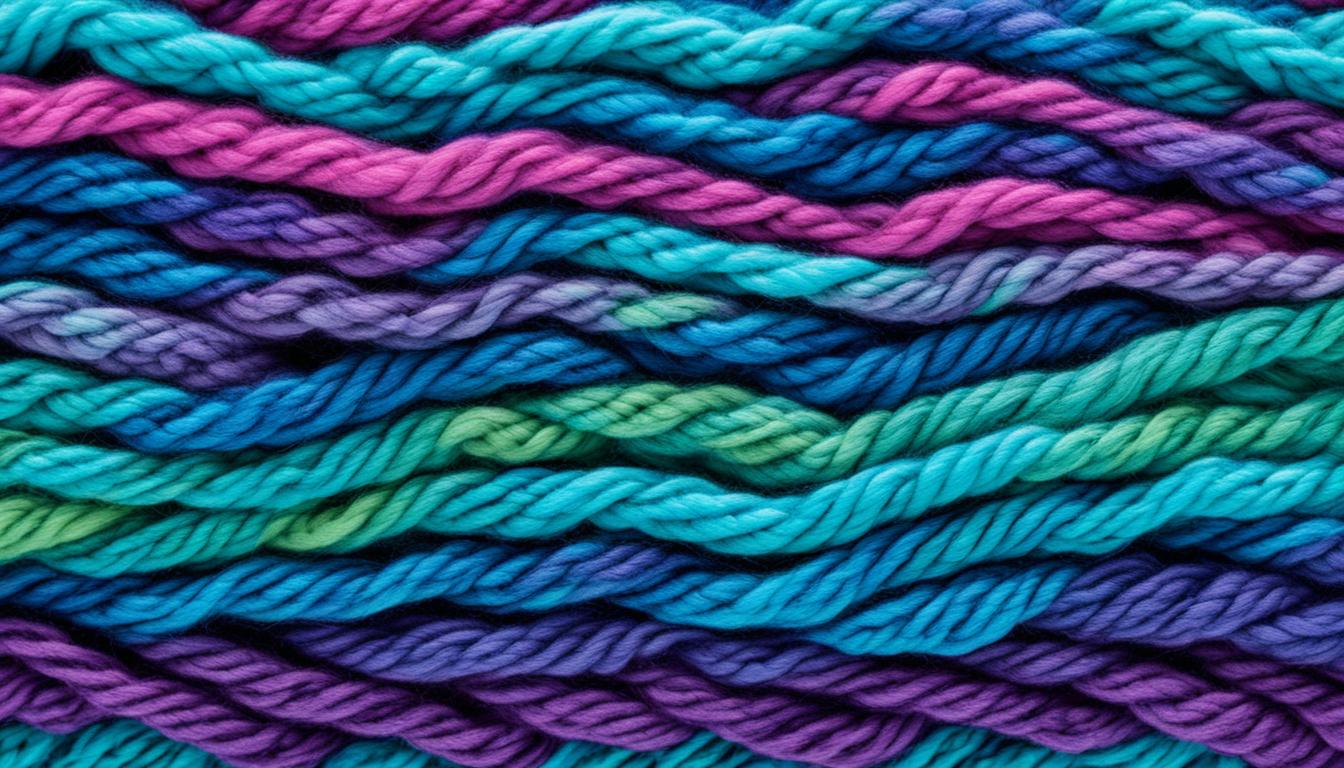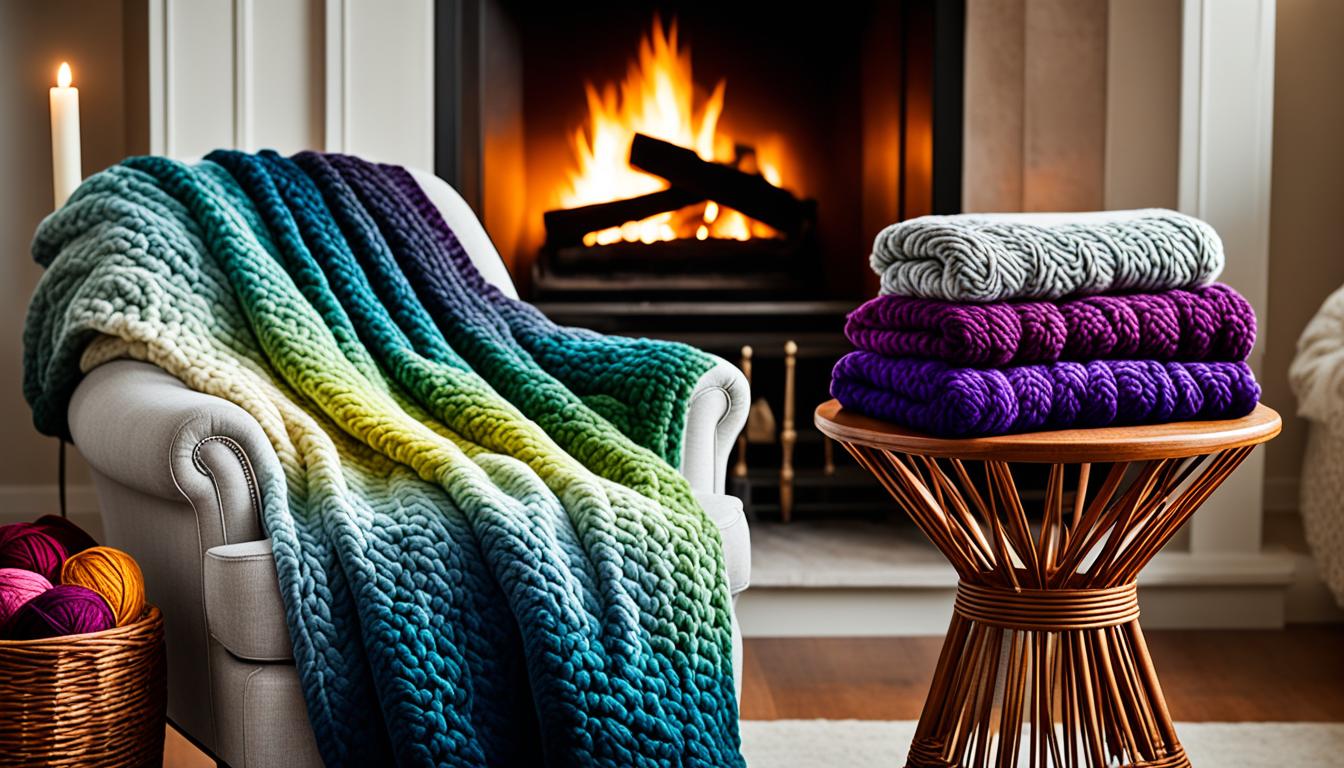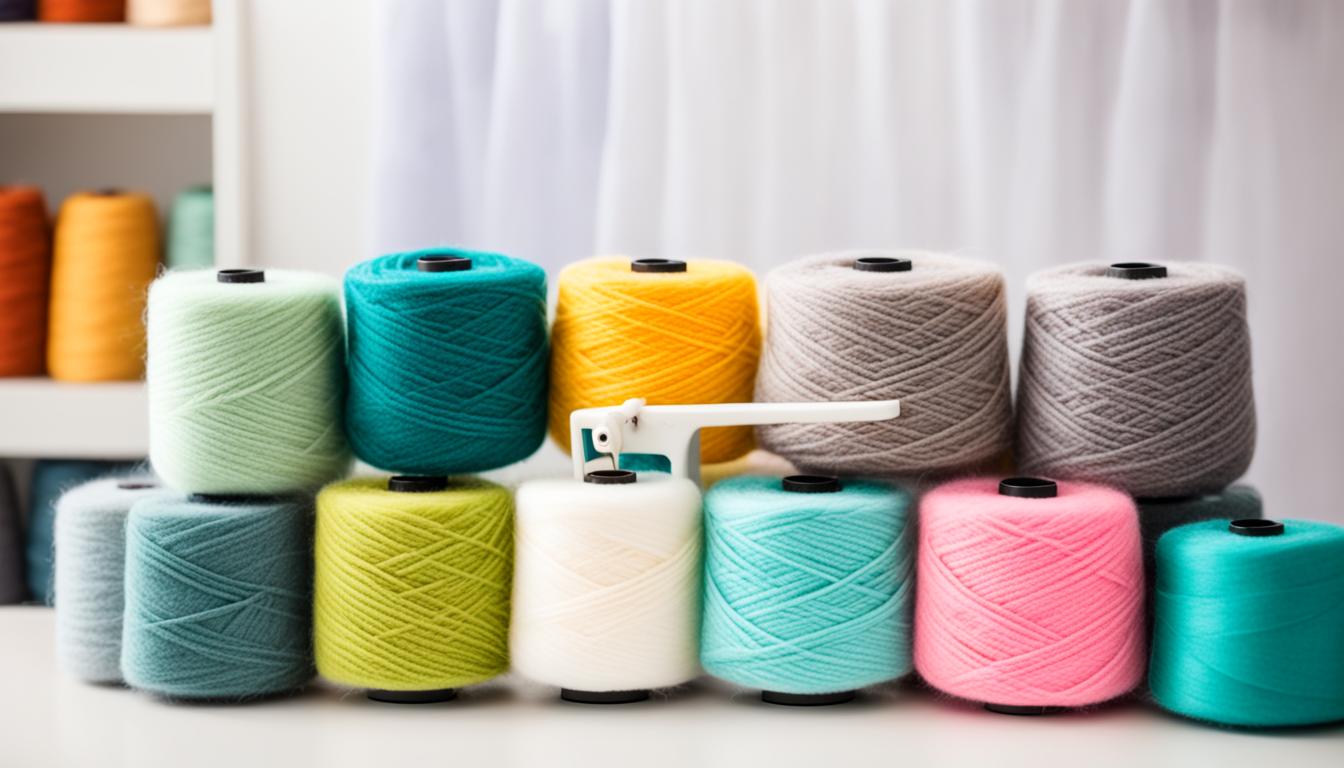Welcome, parents and craft lovers! When it comes to making handmade items for our little ones, we always aim for the highest quality. However, have you ever questioned whether the yarn we are using is really safe for babies? There are key considerations to keep in mind, from softness to allergens, to guarantee our babies’ safety and well-being. Let’s uncover the facts and reveal the mysteries surrounding baby-friendly yarns.
In this article, we will explore the key considerations for selecting yarns that are gentle on your baby’s sensitive skin. We’ll delve into the world of baby-friendly materials and discover top brands that prioritize safety. Whether you’re a crocheting novice or a knitting pro, join us as we unravel the mysteries of yarn safety for our precious little ones.
Ready to dive in? Let’s ensure our babies are wrapped in comfort, security, and warmth as we embark on this enlightening journey together!
Key Takeaways:
- Choosing the right yarn for your baby is crucial to ensure their safety and comfort.
- Avoid materials that may irritate your baby’s sensitive skin, such as yarns with beads, fringes, or loose strands.
- Opt for soft yarn options like cotton or acrylics, and pay attention to the safety of buttons and embellishments.
- Proper sizing is essential to prevent discomfort or restricted circulation in baby items.
- When selecting a baby blanket or toy, consider safe materials and construction to minimize potential hazards.
Choosing the Right Yarn for Your Baby
When it comes to selecting yarn for your baby, it’s essential to prioritize their safety and comfort. Not all yarns marketed as “baby yarn” are necessarily safe for infants, so it’s crucial to make an informed choice. We understand that your baby’s delicate skin requires gentle and non-irritating materials. Let’s explore some key factors to consider when choosing the perfect yarn for your little one.
Softness Matters
One of the most important considerations is the softness of the yarn. Opt for yarns that are specifically designed to be soft and gentle on sensitive baby skin. Cotton yarns are generally safe options, offering both softness and breathability. They are hypoallergenic and less likely to cause any discomfort or allergies. Additionally, you can explore a variety of soft acrylic yarns, such as Caron Simply Soft and Red Heart Soft, which provide a cozy and baby-friendly texture.
Avoid Scratchy and Allergenic Materials
Some yarn materials, like wool, may be scratchy and cause irritation or allergies in babies. It’s best to avoid these materials and prioritize yarns made from non-allergenic fibers. We recommend carefully reading the yarn’s label to ensure it doesn’t contain any potential allergens or irritants.
Consider the Season
Seasonal considerations are also important when selecting yarn for your baby projects. In colder weather, acrylic yarns provide warmth and insulation, making them an excellent choice for blankets and clothing items. In contrast, during the summer months, breathable cotton yarns help regulate body temperature, keeping your little one cool and comfortable.
Pro Tip: Prudence in choosing the right yarn is key to ensuring your baby’s ultimate comfort and safety.
To summarize, always prioritize the softness and comfort of the yarn when selecting for your baby. Choose non-allergenic materials and consider the season to provide optimal warmth or breathability. By making a thoughtful and informed decision, you can create beautiful and safe handmade items that your baby will love.
Securing and Finishing Baby Items
When it comes to creating handmade items for your baby, safety is our top priority. Ensuring that all buttons and embellishments are securely attached is crucial to prevent any potential hazards. We use strong materials and techniques that can withstand the baby’s playing and pulling, giving you peace of mind.
One important tip to keep in mind is leaving longer tails on your work. This allows for ample yarn to be woven in and all loose ends to be securely tied. By taking this simple step, you can prevent the risk of items unraveling and posing any danger to your little one.
This applies to all baby items, from clothing to toys. We understand that babies explore with their hands and mouths, so we take extra care to ensure all parts are tightly secured, eliminating any chances of them becoming loose or detached.
At our workshop, we follow strict quality guidelines to guarantee the safety of our products. Our team of skilled artisans pays attention to the smallest details, from securely stitching buttons to tightly weaving in all loose ends. We understand the importance of creating baby items that are both beautiful and safe.
“We take great pride in our commitment to baby yarn safety tips. Our dedication to securing and finishing baby items is unmatched in the industry.” – Sarah Johnson, Founder of Baby Bliss Creations
Top Tips for Securing and Finishing Baby Items:
- Choose sturdy materials that can withstand baby’s playtime.
- Double-check that all buttons and embellishments are securely attached.
- Leave longer tails for ample yarn to weave in and secure loose ends.
- Securely stitch all seams to prevent unraveling.
- Ensure all parts are tightly woven and cannot be easily detached.
By following these baby yarn safety tips, you can create beautiful and safe items for your little one. As parents ourselves, we understand the importance of providing the best for our children, and we strive to deliver the same level of care and dedication in our handmade baby products.
In the next section, we’ll explore the significance of choosing the right size for baby items and how it impacts their comfort and safety.
The Importance of Proper Sizing
When it comes to crocheting or knitting for your baby, choosing the correct size is of utmost importance for their comfort and safety. While slightly oversized items may not pose harm, garments that are too tight can potentially cut off circulation, causing discomfort and potential health risks. Therefore, it’s crucial to pay attention to sizing details when creating baby projects.
One key factor to consider when determining the correct size is the gauge of your yarn. Checking the gauge helps ensure that your finished item will match the intended size and fit your baby properly. Acrylic yarns, known for their stretchiness, may require tighter gauge control, while cotton yarns, with less elasticity, may allow for slightly looser gauge measurements.
Additionally, understanding the needs and preferences of your baby helps in choosing the best yarn for their projects. Softness and comfort are crucial factors when selecting yarn for infants, as their delicate skin is sensitive and prone to irritation. Opting for yarns specifically designed for baby projects or those labeled as “baby-friendly” ensures that you’re using materials that are safe and suitable for your little one.
The Best Yarn for Baby Projects
When it comes to choosing the best yarn for baby projects, there are several options that offer both comfort and safety. Some popular choices include:
- Cotton: Cotton yarns are gentle and soft, making them an excellent choice for baby items. They are breathable, hypoallergenic, and easy to care for, making them a favorite among parents.
- Acrylic: Acrylic yarns are soft, affordable, and available in a wide range of colors. They are machine washable and durable, making them ideal for baby projects that require frequent washing.
- Bamboo: Bamboo yarns have a silky feel and are naturally antibacterial, making them a great choice for baby items. They have excellent drape and are also biodegradable, making them an eco-friendly option.
By using these yarn options, you can ensure that your baby’s projects are both safe and comfortable. However, always remember to check the specific yarn’s label for any additional care instructions or precautions.
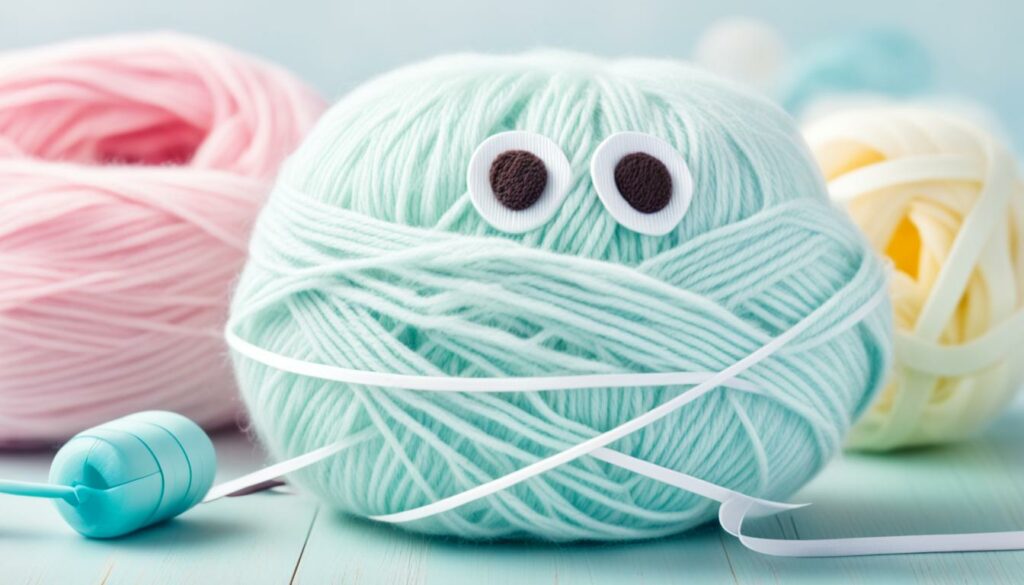
Proper Sizing Tips
Here are some tips to help you ensure proper sizing when creating baby projects:
- Refer to size charts and patterns provided by reputable sources or experienced knitters/crocheters in your community.
- Measure your baby’s size accurately, considering their current measurements and any growth you anticipate during the project completion.
- Keep in mind that babies grow quickly, so it’s advisable to choose a slightly larger size to allow for growth. However, avoid sizing up excessively, as it may lead to discomfort or difficulties in movement.
- If possible, incorporate adjustable features such as buttons or ties to accommodate slight variations in sizing and provide flexibility.
Remember, the key is to prioritize your baby’s comfort and safety when selecting the appropriate yarn and ensuring the correct sizing. By doing so, you can create beautiful, cozy projects that your little one will love.
| Yarn Type | Features |
|---|---|
| Cotton | Soft, breathable, hypoallergenic |
| Acrylic | Soft, affordable, machine washable |
| Bamboo | Silky, antibacterial, biodegradable |
The Safety of Baby Blankets
Your baby’s comfort and well-being are our top priority, especially when it comes to choosing the right materials for their blankets. We understand that safety is crucial, and that’s why we recommend using safe yarn for babies made from soft and durable materials.
When selecting a baby blanket, consider yarns that are gentle on your little one’s delicate skin. Opt for materials such as cotton, bamboo, acrylic, or merino. These options provide a cozy and safe environment, offering warmth without irritating your baby’s skin.
Avoid blankets with open knit patterns that can pose a risk of trapping your baby’s fingers. Instead, choose blankets with tightly woven ends to secure the yarns in place, ensuring their safety while they snuggle up.
In addition to safety, it’s important to consider the season when selecting a blanket material. During colder weather, acrylic blankets provide insulation and comfort, while cotton blankets are breathable, making them perfect for the summer months.
Our recommended safe yarn for babies ensures that your little one is surrounded by cozy, secure, and soft materials throughout their early years.
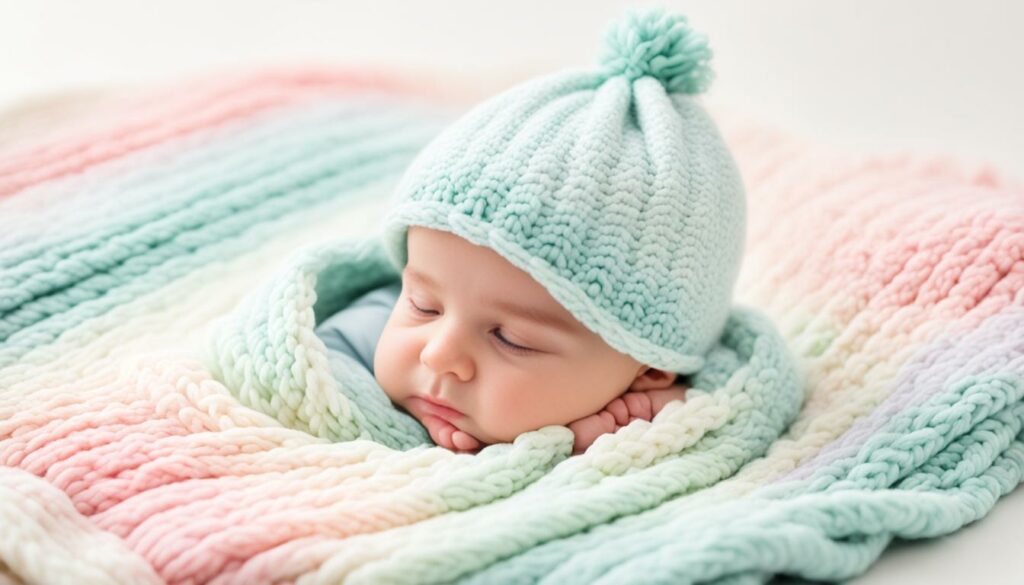
| Recommended Safe Yarn Materials |
|---|
| Cotton |
| Bamboo |
| Acrylic |
| Merino |
Toy Safety Tips for Babies
As parents, we know that toys are not only fun but also an essential part of our baby’s development. However, their safety should always be a top priority. When selecting toys for our little ones, we need to consider their age, materials used, and potential hazards. Here are some important toy safety tips to keep in mind:
- Choose age-appropriate toys: It’s crucial to select toys that are suitable for our baby’s age and developmental stage. Toys with small parts or sharp edges can pose a choking or injury risk for infants. Look for toys labeled with the appropriate age range.
- Opt for safe materials: When it comes to our baby’s toys, we want to ensure that they are made from safe and non-toxic materials. Natural materials like cotton, wool, or uncoated wood are excellent choices. These materials are unlikely to contain harmful chemicals and are gentle on their sensitive skin.
- Avoid choking hazards: Small parts or pieces that can easily detach from toys are potential choking hazards for babies. Make sure all toys are free from loose parts and properly secured. Regularly inspect toys for any signs of wear and tear, such as loose stitching or broken parts.
- Mind the noise level: Some toys can produce loud noises, which may startle or disturb our little ones. Extended exposure to loud noises can be harmful to our baby’s hearing. Opt for toys with adjustable volume settings or ones that emit soft and soothing sounds.
- Beware of cords and strings: Toys with cords or strings longer than 7 inches can pose a strangulation risk. Ensure that all cords are securely attached to the toy and are free from any loops or knots. Keep an eye out for toys with lengthy cords or strings and either remove or shorten them.
- Follow guidelines for electric toys: If you’re considering electric toys, make sure to follow the manufacturer’s guidelines for safe use. Check the batteries regularly and replace them when needed. Avoid leaving electric toys unattended while they are turned on.
- Steer clear of magnets: Toys with small magnets should be avoided, as they can cause serious internal injuries if swallowed. Keep magnetic toys away from your baby, especially if they tend to put objects in their mouth.
By following these toy safety tips, we can provide our babies with a safe and enjoyable playtime experience. Remember to inspect toys regularly for any signs of damage and store them in a secure place when not in use.
We believe that every playtime should be filled with laughter, curiosity, and most importantly, safety.
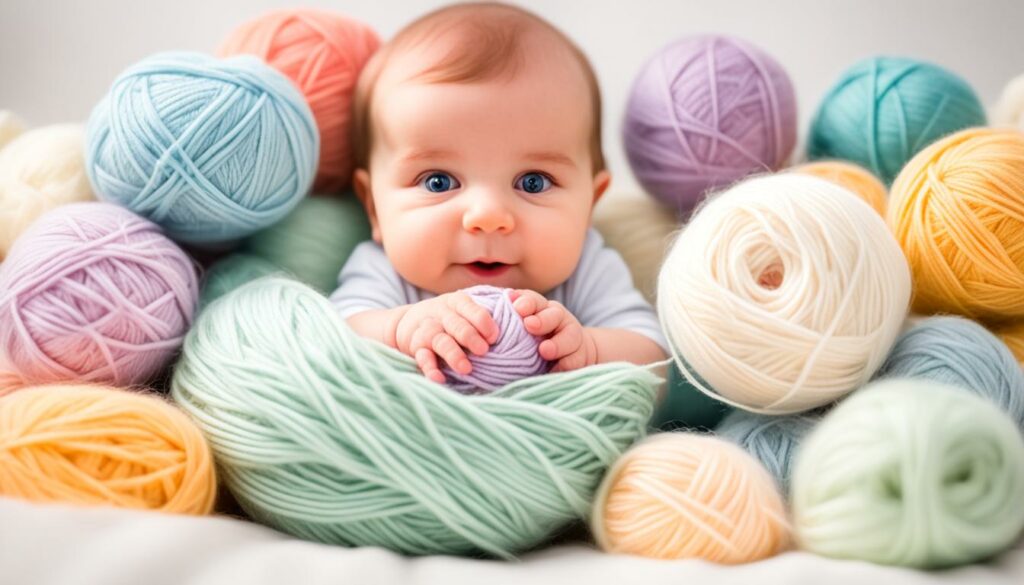
| Toy Safety Tips for Babies | |
|---|---|
| Choose age-appropriate toys | ✔ |
| Opt for safe materials | ✔ |
| Avoid choking hazards | ✔ |
| Mind the noise level | ✔ |
| Beware of cords and strings | ✔ |
| Follow guidelines for electric toys | ✔ |
| Steer clear of magnets | ✔ |
Maintaining Toy Safety
Proper maintenance is essential for ensuring your baby’s toys remain safe and secure. By following these maintenance and safety guidelines, you can create a playtime environment that minimizes risk and promotes your baby’s well-being.
Here are some important steps to take:
- Store toys in a safe place: Keep toys off the floor and out of reach of young children to prevent accidents. Consider using storage bins or shelves that are easily accessible for adults but out of sight for curious hands.
- Regularly check for damage: Inspect toys for any signs of damage such as splinters, sharp edges, or loose parts. Carefully examine wooden toys, sanding or repainting them as needed. Dispose of toys with irreparable damage to eliminate potential hazards.
- Dispose of plastic wrap and packaging: Remove plastic packaging immediately and discard it safely. Plastic wrap and packaging can pose choking hazards if left within reach of babies and young children.
- Follow toy instructions: Read and keep the instructions that come with your baby’s toys. Following the manufacturer’s guidelines ensures that you use the toy correctly and understand any safety precautions or age recommendations.
- Stay informed about recalls: Stay updated on the latest safety recalls through the U.S. Consumer Product Safety Commission (CPSC) website. Regularly check for any recalls that may affect your baby’s toys, and take appropriate action if necessary.
Remember, maintaining toy safety goes hand in hand with providing a nurturing and secure environment for your baby to play and grow.
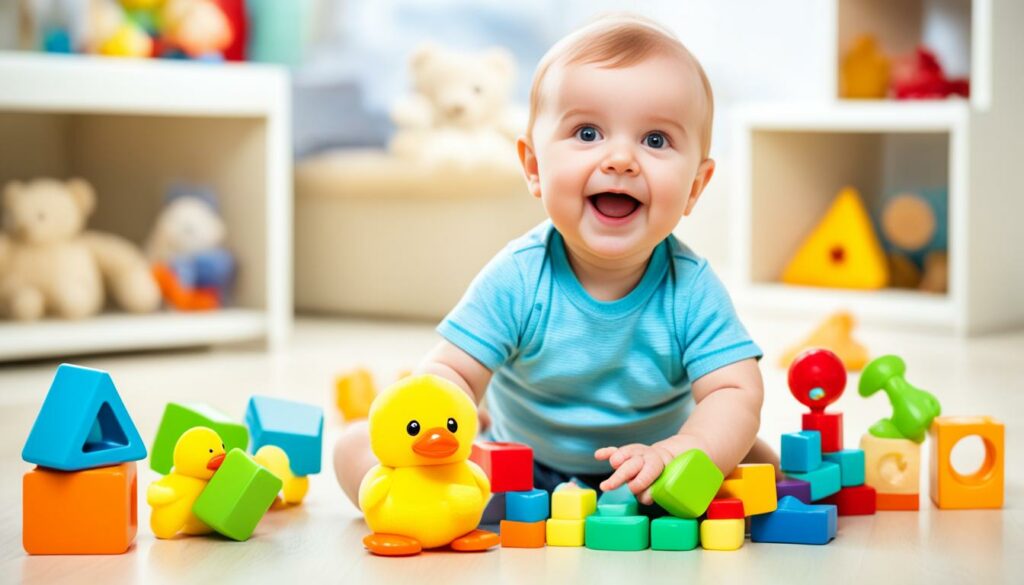
Helping Your Child Grow and Play Safely
As your child grows, it’s important to adapt their play environment to ensure their safety. We want to provide a nurturing space for them to explore and learn. Here are some tips to help you guide their growth and play safely:
Gradual Introduction of Toys and Accessories
Gradually introduce toys and accessories such as blankets and pillows when your child is old enough to handle them safely. This allows them to develop their motor skills and coordination while minimizing potential risks. Start with simple and age-appropriate toys, and as they grow, you can introduce more complex toys that suit their developmental stage.
Pay Attention to Age Recommendations
Always pay attention to the age recommendations on toys and choose toys that are appropriate for your child’s age and developmental level. These guidelines are designed to ensure that the toys are safe and suitable for your child’s stage of growth. By following these recommendations, you can prevent potential hazards and provide toys that are engaging and stimulating for your child.
Supervise Your Child’s Play
It’s important to supervise your child while they play, especially when they are playing with toys that involve small parts or require adult supervision. This ensures that they are engaged in safe and age-appropriate activities. Supervision also allows you to guide their play, teach them how to use toys correctly, and intervene if any safety concerns arise.
Remember, supervision doesn’t mean constant hovering, but rather being present and attentive to your child’s play. It gives you an opportunity to interact with them, bond, and create lasting memories.
Provide Age-Appropriate Toys and Activities
- Choose toys that are specifically designed for your child’s age group. These toys are made with their developmental needs in mind.
- Consider activities that promote their growth and development. For example, puzzles can enhance problem-solving skills, building blocks can improve fine motor skills, and art supplies can encourage creativity.
- Engage in activities that promote physical development, such as outdoor play, dancing, or riding a tricycle.
By providing age-appropriate toys and activities, you are not only ensuring their safety but also supporting their overall development.
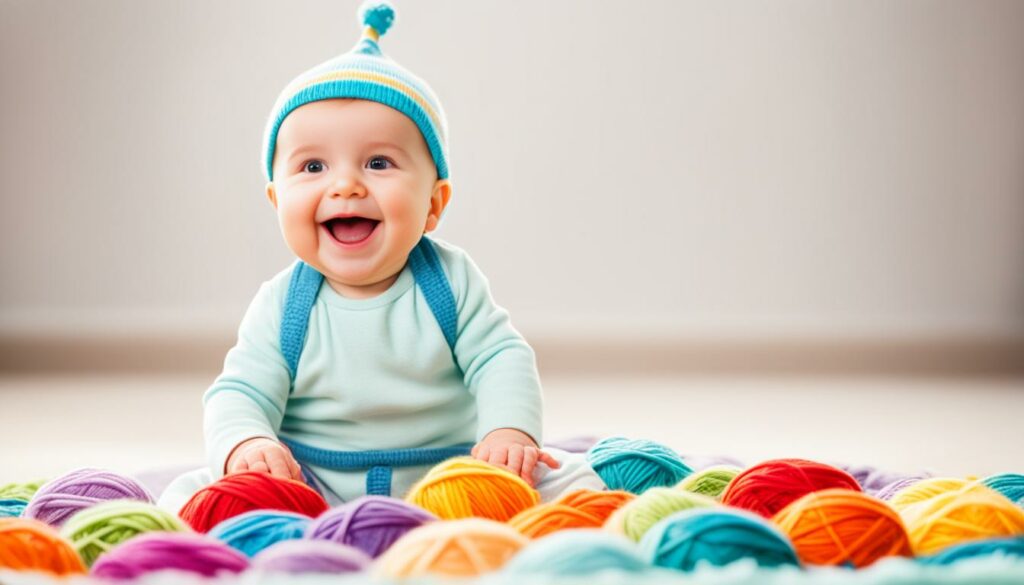
Remember, every child is unique, and their preferences and developmental milestones may vary. Trust your parental instincts and adapt your approach based on your child’s individual needs.
Creating a safe and engaging play environment fosters your child’s curiosity, creativity, and growth. By following these tips and providing a safe space for exploration, you are setting the stage for your child’s development and ensuring their well-being.
Listening to Your Parental Instincts
As parents, we instinctively know what is best for our children. While guidelines and recommendations are important, our parental instincts are invaluable when it comes to ensuring our baby’s safety.
We understand that every baby is unique, with their own individual needs. That’s why we encourage you to trust your instincts and make decisions based on what feels right for your child.
Of course, staying informed and doing our research is crucial. Keeping up-to-date with the latest information on safe yarns for babies and materials is essential to making informed choices.
Consulting with healthcare professionals or experienced parents can also provide valuable insights and advice. Sometimes, hearing from someone who has been in our shoes can offer perspective and reassurance.
“Parental instincts are like a sixth sense that we develop as we bond with our babies. Trusting them allows us to create a safe and nurturing environment for our precious little ones.” – Dr. Sarah Miller, Pediatrician
Remember, you have the final say in determining what is best for your child. No one knows your baby as well as you do, and your instinctive understanding of their needs should guide your decision-making process.
By combining our knowledge and parental instincts, we can create a safe and nurturing environment for our babies to thrive in.
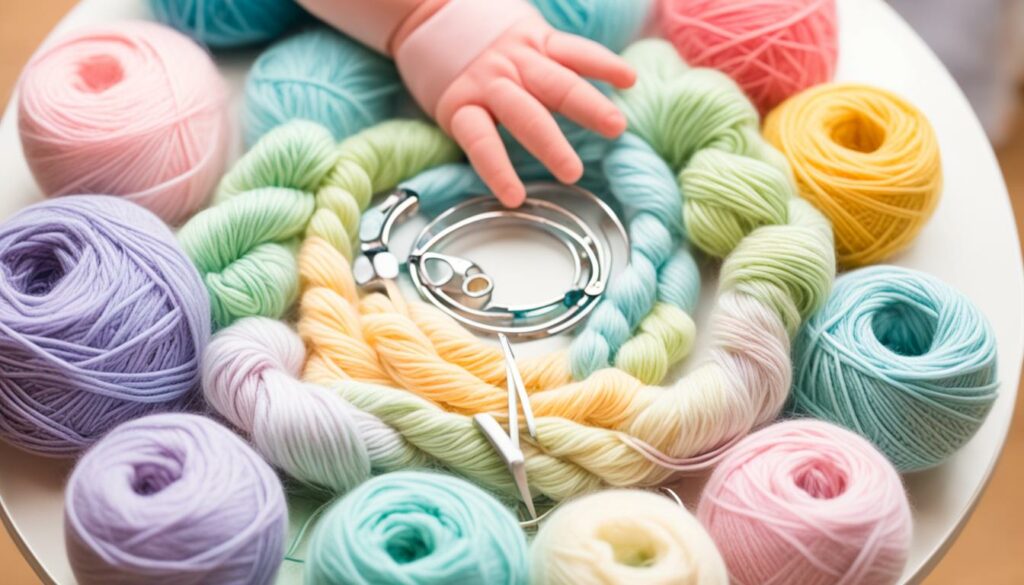
Trusting Your Intuition
Trusting our intuition as parents is essential in navigating the vast array of choices we encounter when it comes to our baby’s safety. Whether it’s selecting the right yarn for their delicate skin or making decisions about their overall care, our instincts often guide us in the right direction.
So, trust yourself, mama, trust yourself, dad. You’re doing an amazing job!
Conclusion
When it comes to using yarn for baby projects, ensuring the safety of our little ones is our top priority. We must take precautions when choosing yarns, selecting materials that are soft, non-irritating, and free from choking hazards. Look for reputable baby safe yarn brands that prioritize quality and safety.
It’s crucial to secure all embellishments and finishings properly to prevent loose strands that could pose a risk. Additionally, consider the season when choosing materials, opting for breathable cotton in the summer and cozy acrylics in colder weather.
Toy safety is equally important. Choose age-appropriate toys made from baby safe yarn materials, such as non-toxic cotton, wool, or uncoated wood. Regularly inspect toys for any damage and ensure they meet safety guidelines.
By prioritizing safety and listening to our parental instincts, we can create a safe and nurturing environment for our little ones. With the right materials and thoughtful precautions, we can enjoy knitting and crocheting for our babies, knowing that their comfort and well-being are always at the forefront.
